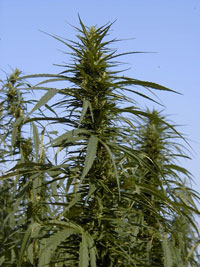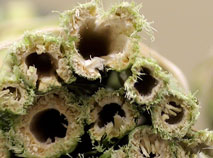Industrial Hemp Production
Industrial Hemp was commercially produced in the 1800’s in many parts of the world. It was used to manufacture rope, cloth, sails and paper etc.The introduction of cotton and petroleum products and new processing techniques for these products lead to the demise of the hemp industry in the early 1900’s. Legislated changes in North America at the time also made the propagation of known varieties virtually impossible.
Currently limited research is available for industrial hemp production in Manitoba. The hemp industry, innovative producers and Manitoba Agriculture and Resource Development have developed hemp production systems. Local breeding programs, expanded producer knowledge and the establishment of processing plants for seed and fibre are having a positive impact on the growth of the hemp industry in Manitoba.
Background
Industry Background
Industrial hemp production has remained legal throughout most of the world. There are approximately 30 countries from Europe, Asia and North and South America that currently allow farmers to grow hemp. The world hemp fibre market continues to be dominated by China . Other notable countries include France, Germany, UK, Chile and the Democratic People’s Republic of Korea.
There was a steady decline in world acreage up to the early 2000’s. In the 1930’s, the anti-marijuana crusade gained momentum in North America with the passage of an act in the USA that prohibited its use and circulation. Canada followed suit in 1938 with the introduction of the Opium and Narcotics Control Act. This was basically the end of hemp production in North America until the mid 1990’s. Hemp varieties with low THC (delta-9-tetrahydrocannabinol) levels have been developed, and in March of 1998 the ban was lifted, permitting the production of hemp under license with Health Canada. Canada has adopted a THC level of 0.3% as the concentration that differentiates non-narcotic from narcotic cultivars. Most varieties being grown in Canada today have originated in Eastern European countries. In recent years, Canadian adapted varieties have been registered and are becoming available to producers. In Canada, Industrial Hemp is viewed as a new alternative crop that compliments prairie crop production rotations. It breaks the traditional crop disease cycles affecting cereals while offering enhanced cropping profits for farm businesses.
Industrial hemp is a high volume renewable source of quality fibre. The fibre is well suited for supplementing or substituting non-renewable sources of fibre. It can be used in big market products such as paper, insulation and biocomposites or in the horticultural industry. The full plant utilization of hemp and flax crops has a high potential in the emerging bio-economy.
Manitoba Industrial Hemp Industry
Manitoba growers have been quick to recognize the potential of the crop once industrial hemp was licensed for production in Canada. In Manitoba, hemp grows under a wide variety of climate and soil types. The adaptability of hemp makes it ideal for areas of the province that have limited cropping options and where high value crops such as edible beans and sunflowers are considered high risk.
Manitoba farmers have been very innovative in growing, and harvesting the crop. Harvesting can be challenging when some varieties grow up to 10 to 12 feet tall. Producers have made the necessary equipment modifications at the farm level to overcome many of these obstacles.
The Industrial Hemp Industry is a new industry in Western Canada. Existing Manitoba grain processors include
Hemp Oil Canada (Ste. Agathe, MB),
Manitoba Harvest (Winnipeg, MB), and
Hempco (McGregor, MB). These companies primarily crush industrial hemp grain for oil, de-hull for the nut, protein powder, flour, milk and other products. Other grain processing companies using Manitoba hemp grain are located in Alberta, Ontario, and Quebec.
Parkland Industrial Hemp Growers Coop Ltd. (PIHG) is a grower directed Co-op located in Dauphin. A plant breeding program has been initiated by PIHG with variety selection emphasis on high grain and/or fibre yield, large seed size and low THC levels. PIHG is a group of dedicated growers prepared to grow hemp for either grain or fibre and they will facilitate contracts for growers.
Fibre processing is in the development stages in Manitoba. At present, the Emerson Hemp Distribution Company is the only company that processes raw hemp fibre into specific useful components. Plains Industrial Hemp Processing (PIHP) is located at Gilbert Plains, Manitoba and construction was completed in 2013. They are currently testing their equipment and production lines. Contracted acres for fibre production will be available in 2014.
Manitoba grain production is summarized in Table 1. The data was taken from Manitoba Crop Insurance seeded acreage reports. Table 1 indicates the total acres grown in Manitoba and the average grain yields per acre (lbs). Overall the industry has grown but acres continue to fluctuate based on market demand and prices. Average grain yields from 2011 to 2020 have held between 600-800 lbs/acre, with 2020 bringing in the highest average at 866 lbs/acre.
Hemp acres and average yields for your municipality or risk area can be found using MASC's Variety Yield Browser
Table 1: Manitoba Industrial Hemp Acres
|
|
|
|
|---|
| 2011 |
2,753 |
613 |
|
|---|
| 2012 |
11,403 |
649 |
|
|---|
2013
2014
2015
2016
2017
2018
2019
2020 |
10,614
15,327
19,032
12,044
24,227
8,087
6,072
5,865 |
691
656
792
724
718
744
615
866 |
|
|---|
Description
Hemp is an annual and a member of the Cannabaceae family which consists of two accepted genera, Cannabis (hemp) and Humulus (hops). Industrial hemp is a distinct crop type of the plant species Cannabis sativa L.. Industrial hemp is distinguished from narcotic hemp by having a THC (delta - 9 - Tetrahydracannabinol) level less than 0.3%. Other characteristics typical of hemp are slender stems, plant height ranging from four to fifteen feet and a stem diameter from 1/4" to 3/4". The innermost layer of the stem is called the pith. It is surrounded by a woody material known as hurd. Outside of this layer is the growing tissue which develops into hurd on the inside and bast fibers on the outside.
The amount of stem branching is inversely related to plant density, ie lower plant densities promote more branching. The leaves are of a palmate type and each leaf has seven to eleven leaflets with serrated edges. The root system generally consists of a dominant taproot and some lateral roots. Soil type will affect which root type will be more developed. For example, in poorer soils the lateral roots will be more developed and the taproot will be short.
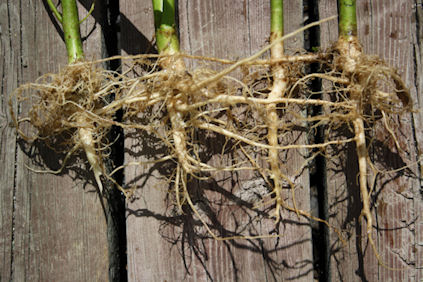 |
| Hemp Root |
Industrial hemp exhibits a dual response to day length. Increasing day length during the first two to three months promotes more vigorous vegetative growth. Later in the season, the plants require shorter day length to trigger flowering and maturation. Typically the plants require an uninterrupted dark period of 10 to 12 hours to induce fertile flowers.
Industrial hemp flower types are described as monoecious and dioecious. Monoecious plants have the male and female flowers on the same plant. The male flowers are arranged in whorls at the base of the flower head while the female flowers are formed at the top. Monoecious types are more common in French cultivars. To establish a monoecious population, it requires six to eight generations of selection for the “ideal” monoecious trait. A certain degree of yearly rouging is required to maintain “ideal” monoecy. The Sengbusch Classification system defines five degrees of monoecious forms: Type 1, 80-90% male flowers; Type 2, 60-70% male flowers; Type 3, 40-50% male flowers; Type 4, 10-30% male flowers; Type 5 less than 10% male flowers. The second and third types are considered “ideal” for monoecious cultivation. The predominantly male (1st degree) and predominantly female (4th and 5th degree) types are removed before flowering. 20-25% of self-pollination takes place in monoecious hemp. The methods developed by R. von Sengbusch and H. Neuer (1943) are the foundation of the breeding technology for monoecious hemp.
Industrial hemp is predominantly dioecious which means a plant will have either all male or all female flowers on it. The plants are anemophilous, meaning they rely on the wind to conduct the pollination process. Prior to flowering the sex of the plant is indistinguishable except for some general trends in growth habit. For example in less crowded growing conditions, the female plants tend to be shorter with more branching than the male plants. When inflorescent development commences, the male flower primordium can be identified by its curved crab’s claw shape. This is followed by the development of dense clusters of round pointed flower buds that have five radial segments. The female primordium is identified by the enlargement of a tapered curved tubular bract (floral sheath). Male flowers hang from long, multibranched, loose clusters formed of small individual flower buds along an axis up to 30 centimeters long. Female flowers are more tightly clustered and have two long white, yellowish or pinkish stigmas protruding from each bract. The bract is two to eight millimeters long and adheres closely to the single ovary and completely surrounds it. The male plant will die soon after the pollen is shed and the female plant continues to grow and develop seeds.
The ratio of male to female plants in a population will vary. Under average conditions of 12 to 14 hour day length, the ratio of males to female will be equal. But under conditions of extreme stress, such as nutrient excess or deficiency, mutilation, extreme cold, or radically altered light cycles, populations have shown to migrate away from the traditional one-to-one ratio.
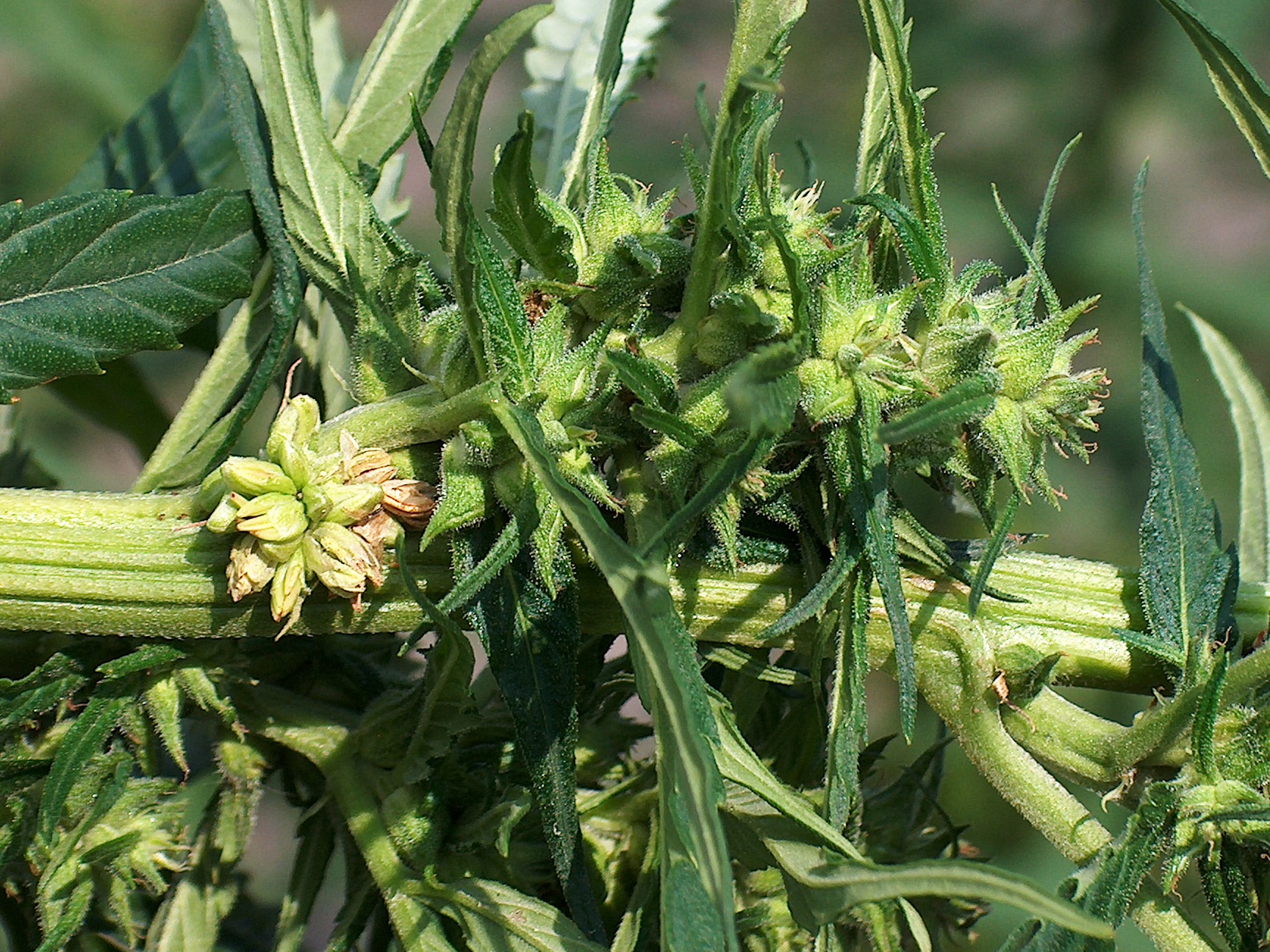 |
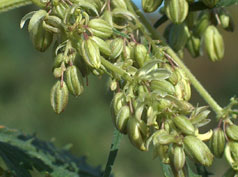 |
| Monoecious Head |
Male Head - Dioecious |
Currently in Canada, the grain industry is driving the development of the hemp crop. The most common hemp seed product is the shelled seed, sometimes referred to as the "hemp seed nut." Other major hemp food products are hemp seed nut butter, which resembles peanut and other nut butters, cold-pressed hemp seed oil, hemp seed flour and protein powder. These basic products can be consumed alone or used in appropriate recipes with or as substitutes for other grains, seeds, nuts, and oils.
Pressed Hemp seeds are approximately 30 to 35% oil by weight. The seed cake is about 25% protein. The hemp seeds also have marketable protein and fiber profiles that add to its overall profitability. Hemp seed contains an oil profile that is of interest for its nutritive properties. It has a favorable balance of omega-6 to omega-3 fatty acids, relatively high contents of gamma-linolenic acid (GLA) and antioxidants. Hempseed oil is being used in various cosmetic products and it has potential in industrial applications such as inks, paints, and fuel. Hemp oil is gaining recognition in the health care market because of the desirable low levels of unsaturated fatty acids in the oil. Hempseed meal has recently found a use in the brewing of specialty hemp beers.
Industrial hemp is a new crop to Canada that lends itself to the agriculture industry by being rural based and has the potential for total crop utilization for grain and fibre processing. The fibre, due to its bulky nature and cost of transportation, lends itself to developing processing and value added industries. The hemp industry as a whole has the potential to enhance the development of rural infrastructure.
Licensing
Industrial hemp was licensed for cultivation in Canada in March of 1998 under licenses and authorizations issued by Health Canada.
Licensing under Health Canada guidelines tightly controls industrial hemp production. All hemp in Canada must be grown from certified seed, licensed and be low in THC (delta - 9 - Tetrahydracannabinol). All varieties are testing well below the 0.3% maximum limit. Licensing requirements prohibit replanting of bin run seed by producers.
Hemp regulations are administered by Health Canada’s Office of Controlled Substances (OCS). Persons carrying out any activity involving hemp must be licensed. Possession of hemp plant parts or products without the appropriate license is a criminal offence. Exceptions to this are mature stalks without leaves, branches or flowers, and non-viable seeds.
A license is issued for one calendar year for: cultivating, importing, exporting, processing, distributing, possessing, plant breeding, analyzing, and research.
Producers applying for an industrial hemp license to cultivate hemp will find the complete licensing application on the
Health Canada Website.
Along with an annual license, a criminal check is required each year which are available from the local RCMP detachment for a cost of $10.00. Consent can also be given to Health Canada to obtain this check directly as part of the annual application.
Health Canada will not license cultivation of less than 10 acres, except in special circumstances. The location must be at least 1 km from school grounds or other places frequented by persons less than 18 years of age.
Growers must give the G.P.S. (Global Positioning System) coordinates of the location where they plan to grow hemp. This means that G.P.S. coordinates are required to define or outline the location - i.e. if the proposed field is rectangular in shape, coordinates for the four corners are required. "UTM" format is preferred to degrees-minutes format for recording the G.P.S. coordinates.
Contact Health Canada for detailed licensing requirements.
Send completed license applications to:
Office of Controlled Substances
Head, Industrial Hemp Section
Healthy Environments and Consumer Safety Branch
Address Locator #3502A
123 Slater Street, 2
nd Floor
Ottawa ON KlA lB9
E-mail:
Health Canada
THC Sampling And Analysis
As part of the license requirements for growing hemp, producers must provide proof that their hemp crop has a THC level of less than 0.3 %. This is done by hiring the services of a person approved by Health Canada as a hemp sampler. A list of approved samplers is available from the Health Canada’s Office of Controlled Substance website). It is the responsibility of the grower to make sure the crop is sampled if it is not on the Health Canada exempt list.
The sampler must follow the Health Canada guidelines outlined in Guidance on Sampling and Analysis of delta-9 THC (Tetrahydrocannabinol) in Hemp to collect samples, dry them and submit them to an approved Laboratory for analysis. The laboratory analysis determines the level of THC found in the crop sample and provides a report to the grower.
Market Potential
Currently the grain side of the hemp industry is the driving force for acreage. Fibre markets and processing capability is being developed with the first fibre processing plant contracting in 2014.
There are numerous companies in Manitoba that contract hemp seed for production of food and body care products. Food products include oil, dehulled hemp seeds or nut, milk, flour, toasted hemp seed, coffee, butter and protein powder. Body care products include shampoo, conditioner, hand lotion and lip balm.
In general, producers considering hemp as a cropping option should research hemp production guidelines and processor options so they fully recognize the benefit and cost to their operation. Contracts are recommended to ensure a market and an economical return. Based on research and producer experience, hemp is well adapted to Manitoba with good yieldability, disease resistance and potential return on investment. Markets continue to develop and processors are expanding their processing capacity to accommodate the rise in demand for their products. It is important to re-iterate the need for a license from Health Canada to legally grow industrial hemp.
Cost Of Production
Cost of production will vary with individual operations and circumstances.
Cost of production for all crops (including hemp) can be downloaded from the MB ARD website. These are guidelines that will help you compare hemp to other crops you may be considering to grow on your farm. It is important to replace these budget costs with your own costs to evaluate the potential and impact on your farm operation.
Commercial hemp grain contract price ranged from $0.75 to $0.84 per pound for clean high quality grain. Organic production price is generally 30 to 40% higher depending on the contractor.
Links
Provincial Agricultural Websites
Manitoba Industry and Contractors
Industry Organizations, Research and Resources
